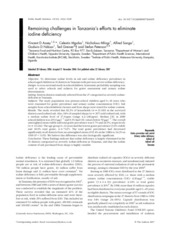| dc.contributor.author | Assey, Vincent Didas | en_US |
| dc.contributor.author | Mgoba, Celestin | en_US |
| dc.contributor.author | Mlingi, Nicholaus | en_US |
| dc.contributor.author | Sanga, Alfred | en_US |
| dc.contributor.author | Ndossi, Godwin D. | en_US |
| dc.contributor.author | Greiner, Ted | en_US |
| dc.contributor.author | Peterson, Stefan | en_US |
| dc.date.accessioned | 2010-01-06T13:53:33Z | |
| dc.date.available | 2010-01-06T13:53:33Z | |
| dc.date.issued | 2007 | eng |
| dc.Published | Public Health Nutrition 10(10): 1032-1038 | en |
| dc.identifier.issn | 1368-9800 | |
| dc.identifier.uri | https://hdl.handle.net/1956/3719 | |
| dc.description.abstract | Objective: To determine iodine levels in salt and iodine deficiency prevalence in school-aged children in 16 districts in Tanzania with previous severe iodine deficiency. Design: A cross-sectional study in schoolchildren. Systematic probability sampling was used to select schools and subjects for goitre assessment and urinary iodine determination. Setting: Sixteen districts randomly selected from the 27 categorised as severely iodinedeficient in Tanzania. Subjects: The study population was primary-school children aged 6–18 years who were examined for goitre prevalence and urinary iodine concentration (UIC). Salt samples from schoolchildren’s homes and from shops were tested for iodine content. Results: The study revealed that 83.3% of households (n = 21 160) in the surveyed districts used iodised salt. Also, 94% of sampled shops (n = 397) sold iodised salt, with a median iodine level of 37.0 ppm (range 4.2–240 ppm). Median UIC in 2089 schoolchildren was 235.0 μg 1-¹ and 9.3% had UIC values below 50 μg 1-¹. The overall unweighted mean visible and total goitre prevalence was 6.7% and 24.3%, respectively (n = 16 222). The age group 6–12 years had the lowest goitre prevalence (3.6% visible and 18.0% total goitre, n = 7147). The total goitre prevalence had decreased significantly in all districts from an unweighted mean of 65.4% in the 1980s to 24.3% in 1999 (P < 0.05). We believe this difference was also biologically significant. Conclusion: These findings indicate that iodine deficiency is largely eliminated in the 16 districts categorised as severely iodine-deficient in Tanzania, and that the iodine content of salt purchased from shops is highly variable. | en_US |
| dc.language.iso | eng | eng |
| dc.publisher | Cambridge University Press | eng |
| dc.relation.ispartof | <a href="http://hdl.handle.net/1956/3718" target="blank">Controlling iodine deficiency disorders through salt iodation in Tanzania</a> | eng |
| dc.subject | Goitre prevention and control | eng |
| dc.subject | Urinary iodine deficiency | eng |
| dc.subject | Iodised oil | eng |
| dc.subject | Iodised salt | eng |
| dc.subject | Tanzania | eng |
| dc.title | Remaining challenges in Tanzania’s efforts to eliminate iodine deficiency | en_US |
| dc.type | Peer reviewed | |
| dc.type | Journal article | |
| dc.description.version | publishedVersion | en_US |
| dc.rights.holder | The Authors | |
| dc.identifier.doi | https://doi.org/10.1017/s1368980007666695 | |
| dc.subject.nsi | VDP::Medisinske Fag: 700 | nob |
